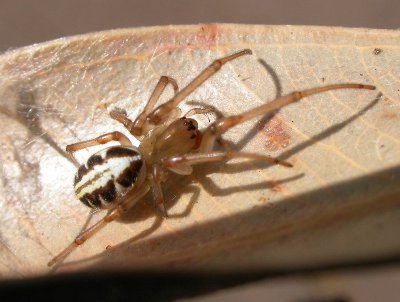Leaf-curling Spider
Category: Arachnida Spider

Facts about Leaf-curling Spiders, "Scientific name for Leaf-curling Spider is Phonognatha graeffei". The leaf curling spider is a spider that is commonly found in the southern parts of the Australian forests and woodland, the main reason why it is called the leaf curling spider is that it uses the leaves in the middle of the web to protect itself from predators such as birds. The Leaf-curling Spider has red-brown cephalothorax and the legs, more so the abdomen has a creamy yellow pattern on the upper side which is irregular; the spider has long legs with oval shaped abdomen.
The leaf curling spiders uses silk threads to curl the leaves so as to form a protective cylinder which is closed at the top and open at the bottom, the Leaf-curling Spider sits inside the cylinder only with their legs showing so as to feel the vibrations of the insect that has been captured. A mature male Leaf-curling Spider takes residence in the web of the female immature spider, mating will then begin as soon as the female matures and the female lays eggs within another curled leaf which is outside the web. More so the Leaf-curling Spider only goes outside the web when rebuilding its web or when a prey falls into the web.
More so the bites from the leaf curling spider might not be considered poisonous in that it is very shy and this makes it to be reluctant to biting people, if bitten by the leaf curling spider possible curling will occur and it is considered local pain, the leaf curling spiders also rely on vibrations through the webs that they live on and this is because they have poor eyesight, also they build their webs at night. The Leaf-curling Spider preys on small insects such as the aphids, mosquitoes, lady beetles and ants that are caught in the web, they are then immobilized by the spider and their body fluids are consumed.
Spiders belong to a group of animals called "arachnids", mites and Scorpions and a tick is also in the arachnid family. An Arachnids is a creature with eight legs, two body parts, no antennae or wings and are not able to chew on food. Spiders are not insects because insects have three main body parts and six legs and most insects have wings.
The Arachnids are even in a larger group of animals called "arthropods" an invertebrate animal of the large phylum Arthropoda, which also include spiders, crustaceans and insects. They are the largest group in the animal world, about 80% of all animals come from this group. There are over a million different species. There are more than 40,000 different types of spiders in the world.
Leaf-curling Spiders do not have a skeletons. They have a hard outer shell called an exoskeleton-(a rigid external covering for the body in some invertebrate animals). The exoskeleton is hard, so it can’t grow with the spider. The young Leaf-curling Spiders need to shed their exoskeleton. The spider has to climb out of the old shell through the cephalothorax. Once out, they must spread themselves out before the new exoskeleton will harden. Know they have some room to grow. They stop growing once they fill this shell. Female Leaf-curling Spiders are usually bigger than males.
Female Leaf-curling Spiders lay eggs on a bed of silk, which she creates right after mating. Once the female spider lays her eggs, she will than cover them with more silk.
Leaf-curling Spiders have oversize brains.
In the Leaf-curling Spider the oxygen is bound to "hemocyanin" a copper-based protein that turns their blood blue, a molecule that contains copper rather than iron. Iron-based hemoglobin in red blood cells turns the blood red
Leaf-curling Spiders have two body parts, the front part of the body is called the Cephalothorax-(the thorax and fused head of spiders). Also on this part of the body is the Leaf-curling Spider’s gland that makes the poison and the stomach, fangs, mouth, legs, eyes and brain. Leaf-curling Spiders also have these tiny little leg-type things called (pedipalps) that are next to the fangs. They are used to hold food while the spider bites it. The next part of the Leaf-curling Spiders body is the abdomen and the abdomens back end is where there is the spinnerets and where the silk producing glands are located.
The muscles in a Leaf-curling Spiders legs pull them inward, but the spider can't extend its legs outward. It will pump a watery liquid into its legs that pushes them out. A Leaf-curling Spider’s legs and body are covered with lots of hair and these hairs are water-repellent, which trap a thin layer of air around the body so the Leaf-curling Spiders body doesn't get wet. It allows them to float, this is how some spiders can survive under water for hours. A Leaf-curling Spider feels its prey with chemo sensitive hairs on its legs and than feels if the prey is edible. The leg hair picks up smells and vibrations from the air. There are at minimum, two small claws that are at the end of the legs. Each Leaf-curling Spiders leg has six joints, giving the spider 48 leg joints. The Leaf-curling Spider’s body has oil on it, so the spider doesn't stick to it’s own web.
A Leaf-curling Spiders stomach can only take liquids, so a spider needs to liquefy their food before they eat. They bite on their prey and empty its stomach liquids into the pray which turns it into a soup for them to drink.
A male Leaf-curling Spider has two appendages called "pedipalps" a sensory organ, instead of a penis, which is filled with sperm and insert by the male into the female Leaf-curling Spider’s reproductive opening.

 Back To Category Arachnida Spider
Back To Category Arachnida Spider